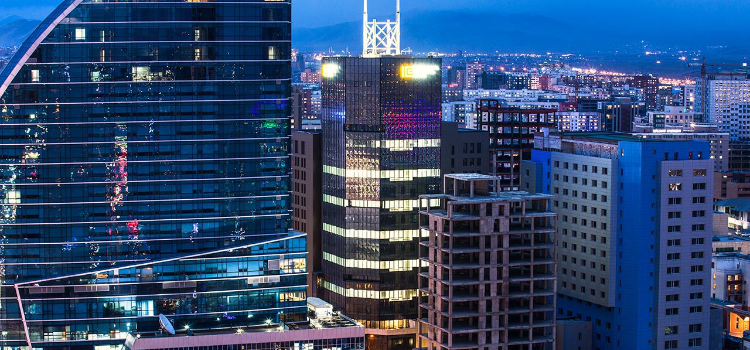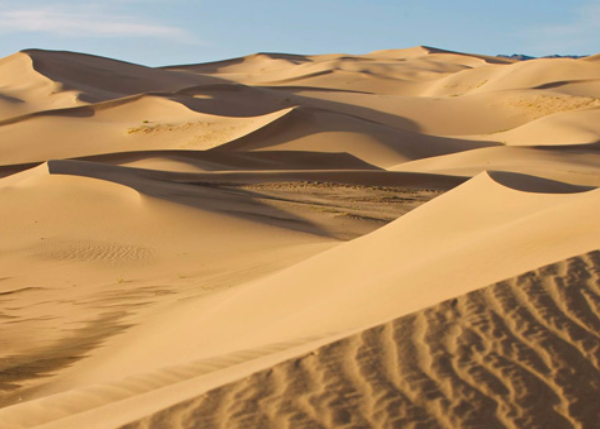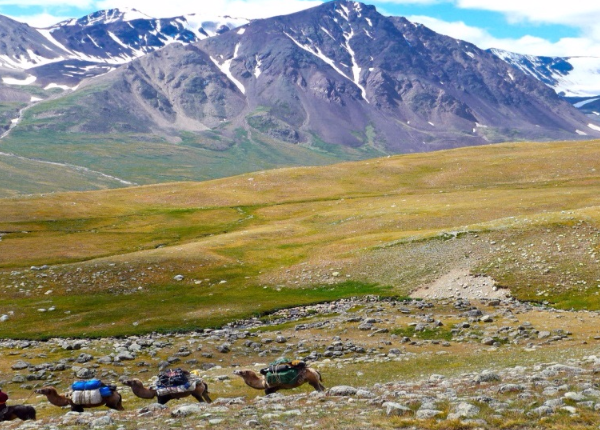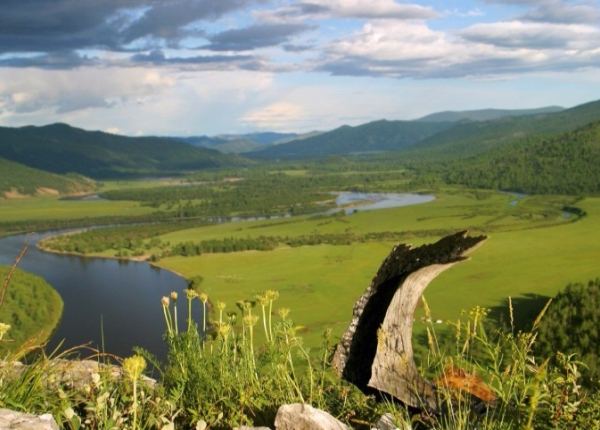Tour description: A journey through Gobi desert and steppes , immersing yourself in the unique beauty of its enormous land. Connect with the local culture by visiting nomadic families, exploring their way of life, and forging new friendships along the way.
Step into one of the most barren and breathtaking landscapes on earth – the Gobi, Asia's largest desert.
Day 1: Ulaanbaatar
Arrival in Ulaanbaatar. Your guide will welcome you and pick you up from the airport. Have dinner and check into the hotel.
Day 2: Baga Gazriin Chuluu
Our expedition begins with a 4-5 hour drive to Baga Gazriin Chuluu, covering approximately 250 km. This place is a picturesque mountain at an elevation of 1,751 meters in the Granite Belt of Mongolia. We will explore the area by walking. Stay overnight in Ger camp. (B/L/D)
Day 3: Tsagaan Suvarga
After breakfast, travel to Tsagaan Suvarga about 280 kms for 5-6 hours. This stunning area is 30 meters high white limestone formation and created over thousands of years by natural wind. Stay overnight in Ger camp. (B/L/D)
Day 4: Yol valley & trekking
After breakfast, we will drive to Yol valley about 220kms. This picturesque place is nestled between the beautiful peaks of the Gurvan Saikhan Mountain and shelters rich wildlife. Visit Gobi museum and trekking through the valley. Stay overnight in Ger camp. (B/L/D)
Day 5: Khongor Sand Dune
Travel to Khongor sand dunes for 180kms. Known as Singing sand dunes, the Khongor dunes are up to 300ms high, 15kms wide, and 180kms long. In the evening, we will walk through the Golden sand dunes. The view is incredible from top of the dunes. Stay overnight in Ger camp. (B/L/D)
Day 6: Visit to nomad family & camel riding
Today we will visit a nomad family and have a chance to see nomadic life in the Gobi. You can taste traditional dairy products made of camel cows’ milk. Optional camel riding is available. Move back to Ger camp. Stay overnight in Ger camp. (B/L/D)
Day 7: Bayanzag
Continue travel to Bayanzag for 170kms. Here you will see saxual forest in the Gobi desert and red flaming cliffs, which formed by the erosion of the sand and rock over many thousands of years. This is the place where dinosaurs were lived 70 million years ago, and is internationally famous for its dinosaur remains of complete skeletons, eggs and hatchlings of the Cretaceous Period. Stay overnight in Ger camp. (B/L/D)
Day 8: Ongi Monastery & trekking
Travel to Ongi Monastery ruin for 140km. Walking along the area where the ancient monastery ruins are situated. Stay overnight in Ger camp. (B/L/D)
Day 9: Drive from desert to steppe
Drive to Orkhon valley for 5-6hours about 240kms. Transitioning from the Gobi to the mountain and steppe zone. In the evening, enjoy a camping experience in the picturesque steppe landscape. (B/L/D)
Day 10: Orkhon waterfall in UNESCO registered Orkhon Valley cultural landscape
In the morning we pack our camping gears and drive to Orkhon Waterfall. Today we will visit nomads who are living in the Khangai, steppe and mountain area. You will be invited to their Gers and offered to taste traditional dairy products like aaruul-dried curds, Mongolian salty milk tea-Suutei tsai, and biscuit-Boortsog and so on. You can make friends with nomads.
Day 11: Kharakhorum & Erdenezuu
After breakfast, start driving to Kharakhorum, the ancient capital city of the Great Mongol Empire. It was also considered to be the centre of the world. We will visit to the Kharkhorum museum as there are no remaining ruins to visit. Next to the museum, discover Erdenezuu Monastery, once the epicentre of Buddhism and among the earliest monasteries constructed in Mongolia. Overnight sleep in a tourist camp.
Day 12: Hustai National Park (289 km)
After breakfast, we will drive to Hustai National Park. This national park is home to the rare and endangered Przewalski’s horses--the only species of wild horses in the world--as well as many other internationally-important plants and animals.
Day 13: Ulaanbaatar (95 km)
Breakfast at camp. Drive to Ulaanbaatar. After lunch at local restaurant, visit Chinggis Khan Musuem. In the evening enjoy with folk art musuem. We will be delighted to drop you off at your hotel. Thank you for joining us on this memorable journey.
Optional airport service for your departure from Ulaanbaatar or tour extension are available based on your wishes*
Highlight
Terelj National Park
Terelj National Park is located at 65 km north east of Ulaanbaatar and recognized as a part of the huge Khan Khentii reserve and was established as a Strictly Protected Area in 1992. To the north-east, the park joins into the Khan Khentii Strictly Protected Area, comprising over 1.2 million hectares of the Tov, Selenge and Khentii aimags.
Show more
Erdene Zuu Monastery
In 1580s, by the order of Dalai Lama first temple of Erdenezuu monastery was built on the ruin of Mongolian ancient capital city Kharkhorin. By 1792s there were 62 temples, over 500 buildings nearby. The monastery was registered in “ Heritage of Mongolia” by UNESCO.
Show more
Khongorym sand dunes
This 180km long range of sand dune is situated at back of Mount Sevrei and Zuulun on west of Mount Gobi Gurvan Saikhan in Umnugobi Aimag. This sand dune is 3-15km wide and 15-30m high. Hundreds of sand dunes will be appeared from top of the Khongoryn Els. The scenery is brilliant with Rocky Mountains on the south, sand dunes in the centre and a river oasis on the north. Floodwater coming down from Mount Zuulun flows through the sand dune and absorbs into the soil. This absorbed water gives rise to a small river Khongor which flows for about 10km to west along the sand dune. At back of the sand dune there are several tourist camps from where one can reach the sand dune by riding or trekking on a camel.
Show more
Ongi monastery
One of the biggest monasteries in Mongolia, Ongi was founded in 1660 and consisted of two temple complexes on the North and South banks of the river Ongi. At its heyday, Ongi monastery grounds housed around 30 temples, 4 big Buddhism universities and over 1000 monks at a time. During 1930s, communism spread throughout Mongolia.
Show more
Tsagaan suvaraga(White stupa)
It was formed over time due to the erosion of a sedimentary mud in the sea bottom and looks like a stupa from far distance. From Far East it looks like a city ruin or a settlement. But, from west it looks like a flat steppe. During the strong storm, herds once died falling into the fissure which is 60m high, about 400m wide and has almost 900 steep banks.
Show more
Sukhbaatar Square
This large and famous landmark is the heart of Ulaanbaatar where the Parliament, the Government House, Stock Exchange and many other important establishments are concentrated. It is named after Sukhbaatar, the famous patriot, whose statue is the main attraction on this square.
Show more
The Capital city
The capital of Mongolia finally settled on its present site in 1778. Territory of the Capital Ulaanbaatar city occupies 470,444 hectares of land, covering areas of the mountain ranges in the tributary basin of the Tuul river west bank, and the Tolgotiin Nuruu range to the north and Bogd Khan mountain. Holy mountains surround it; the Bogd Uul Mountain to the south, the Songino Mountain to the west, the Bayanzurkh Mountain to the east and the Chingeltei Mountain to the north.
Show more
Yolyn am – Vulture gorge
.Yoliin Valley is the narrow canyon of a river that flows through Zuun Saikhan Mountain (2,816m above sea level). The gorge has sheer rock walls with a height of 200m in the central part of the gorge. It has been protected since 1965 and has an area of 70 square kilometers of strictly protected area. A spring is two or three kilometers long. The wind strongly flows through gorge and freezes into a thick corridor of ice that stretches along for a distance
Show more
Khustai Nuruu Protected area
This National Park is a fine example of the wide river valleys separated by hilly terrain that characterize forest steppe. There are dozens of wild animals such as wolves, deer, and Przewalski horse which was reintroduced in 1990 with a cooperation of the Foundation Reserves for the Przewalski Horse and the support of Dutch Government. Since that time Takhi was lived in the zoo parks around the world. Year 1992 was a new stage of Wild horse’s life and its history. Khustai national park was established in order to host reintroduction project of Takhi in 1993.
Show more
Bogd Khaan national park, mountain
In 1783 the Mongolian government made Bogd Khaan Uul a national park to protect its beauty making Bogd Khaan Uul the oldest national park in the world. Its highest point is 2,757 m above sea level. Bogd Khaan Uul was added to the UNESCO World Heritage Tentative List on August 6, 1996 in the Cultural category.
Show more
Baga gazyn chuluu
Situated about 37km northwest from the centre of Delgertsogt Soum, Dundgobi Aimag. This area of granite surrounded by flat plains is located 1768m above sea level covering 300 sq km area.
Show more
Tour price:
Tailored to fit your travel schedule, this tour package offers complete customization from May to October. Tour price per person, as detailed below.
Staying at tourist camp: Staying at nomad family:
2 pax – 2730 USD 2 pax - 2080 USD
3 pax – 2470 USD 3 pax - 1820 USD
4 pax or more – 2210 USD 4 pax or more - 1560 USD
Price included: Price not included:
Hotel in Ulaanbaatar 4* 1 night Travel insurance
Tourist camp 11 nights Visa fee
English speaking tour guide Hotel extra service
Transfer Alcoholic drinks
Meals as mentioned Any charges arising from major force
Entrance to sightseeings events beyond our control
National Park tax
Horseback riding
Museum ticket
Drinking water
Terms & Conditions
Your holiday contract
When you book a tour or other travel arrangements our contract with you takes effect when we send you a written confirmation /by info@tourmongolia.com this e-mail address is being protected from spambots. You need JavaScript enabled to view it/ of booking. Once contract is made we are responsible for providing you with the tour you have booked and you are responsible to pay us for it, in each case subject to terms and conditions.






